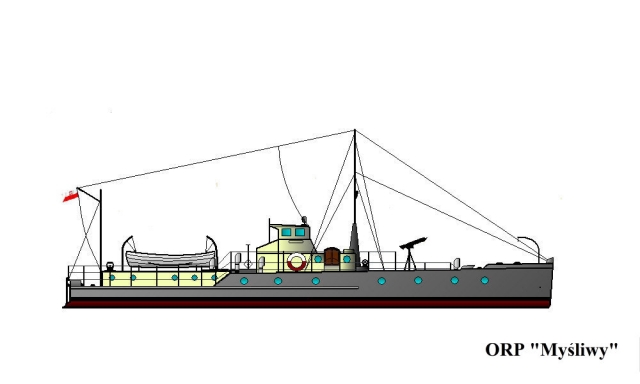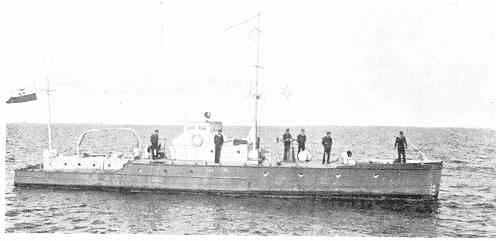The Forgotten Flagship
The story of the Republic of Poland Ship, Mysliwy
Many thanks to Pawel Janicki for this English translation of his Polish page about the "Mysliwy"
The story of the Republic of Poland Ship, Mysliwy
Many thanks to Pawel Janicki for this English translation of his Polish page about the "Mysliwy"
 ORP "Mysliwy" Illustration by Pawel Janicki |
After Poland took over a part of the Baltic coast in 1918, the Department of Naval Affairs (DSM) started collecting offers from various companies. Those offers were mostly about naval units available for purchase by the newly formed fleet. The St. i A. Leszczynski Company offered Poland two ex-German "Odin" class battle-cruisers - those were SMS "Odin" and SMS "Frithjof". The DSM wisely refused, because the young country had no resources to keep such ships and there was no need to purchase them. Although the contract was never signed this started a long cooperation between the Polish Navy and Leszczynski Co. Among other offers of Leszczynski, a special attention was payed to a unit named as “motor ship.” It was, in fact, a Motor Launch (ML). Where did it come from? To date we only know that it came form Allied demobilized stock. There is no certainty if it came from Britain or from France. No documents were found on the matter, Leszczynski documents have been lost through the years. In the authors opinion this unit came from Britain because there a private buyer could buy a boat for civil customers.
There are also questions about the original number of the boat, that it served under before entering its Polish service. The displacement of the unit was 37 tons, so it was a II series ML and had to bear a number between 51 and 550. In January 1921, the DSM sent Leszczynski Co. an order for the ML and signed a contract worth 12.000 US dollars. If we compare that sum to the price for which Britain was selling its boats, we clearly see, that Leszczynski Co made a great profit!
The unarmed ML was towed to Gdansk and docked in Danziger Werf (Gdansk Shipyard), were it underwent extensive renovation and modifications. The most obvious visual change was that the mast was relocated to the front of the steering compartment. It also seems that the steering compartment had some minor changes and some of the deck fittings were removed. Because the boat was unarmed, a 7,92 mm Maxim model 1908 was installed. We know that later on it exchanged for a 47 mm Hotchkiss gun. The ML entered service in the Polish Navy, by the order of DSM, on the 1st April 1921. It was named ORP “Mysliwy” (ORP – Republic's of Poland Ship; “Mysliwy” - “Hunter”).
The “Hunter” entered service in April while still under renovation. The Polish flag did not appear on the boat until July 1921, when it started duty as a guard boat. In summer 1921 an acceptance committee found numerous faults in the engines, which was not uncommon for the ML. First the contracted crew was accused of bad will, but the problems with the engines recurred.
There are also questions about the original number of the boat, that it served under before entering its Polish service. The displacement of the unit was 37 tons, so it was a II series ML and had to bear a number between 51 and 550. In January 1921, the DSM sent Leszczynski Co. an order for the ML and signed a contract worth 12.000 US dollars. If we compare that sum to the price for which Britain was selling its boats, we clearly see, that Leszczynski Co made a great profit!
The unarmed ML was towed to Gdansk and docked in Danziger Werf (Gdansk Shipyard), were it underwent extensive renovation and modifications. The most obvious visual change was that the mast was relocated to the front of the steering compartment. It also seems that the steering compartment had some minor changes and some of the deck fittings were removed. Because the boat was unarmed, a 7,92 mm Maxim model 1908 was installed. We know that later on it exchanged for a 47 mm Hotchkiss gun. The ML entered service in the Polish Navy, by the order of DSM, on the 1st April 1921. It was named ORP “Mysliwy” (ORP – Republic's of Poland Ship; “Mysliwy” - “Hunter”).
The “Hunter” entered service in April while still under renovation. The Polish flag did not appear on the boat until July 1921, when it started duty as a guard boat. In summer 1921 an acceptance committee found numerous faults in the engines, which was not uncommon for the ML. First the contracted crew was accused of bad will, but the problems with the engines recurred.
 ORP "Mysliwy" Image courtesy of Pawel Janicki |
“Mysliwy's” first role was serving as an observation and security boat in the Naval Air Squadron. It served under the Commander of the Naval Air Force and secured the landings and departures of the Polish sea planes. In the beginning of 1922, ORP “Mysliwy” was promoted to a Flag Ship of the Polish Navy, and on the 1st of April 1922 the pennant of the Fleet Command was raised. This happened during the transformation of the Navy into a peacetime organization after the Polish – Russian War 1918 - 21. It has to be underlined that it was not the biggest ship Poland had. By that time, the reborn Navy's biggest ship was ORP “Mazur”, an ex-German V-105. According to an instruction from March 1922, boats orders were to stay in the port in Puck and to secure communications between the Fleet Command and the ships lying in the roads. It was not allowed to leave the port without a special permission. The commander of “Mysliwy” was also in command of a staff boat M56, which provided communication between the roads and the port.
In the period between the 30th May and 22nd June 1922 “Mysliwy” was back in renovation, and its functions were temporally taken by ORP “Rybitwa”, an ex-German mine sweeper FM 31. Until 1924 “Mysliwy” served as a representative ship. It was shapely, shining with brass and, most important, it looked new when compared to other ships of the Fleet. Unfortunately, the problem with the engines was still unsolved. It was extremely unreliable. Jozef Nowak, who served on “Mysliwy” as a chief mechanic between 1923 – 24 wrote that starting the engines was a hard assignment and the boat never ran to its full possible speed due to the severe vibration from the engines. Lack of spare parts was also a problem. Problems with the engine was not only a Polish problem. After years of service the engine was causing screws to loosen and the whole wooden boat was vibrating.
Between 1924 – 25 “Mysliwy” was sent to the Training Squadron. Again it returned to its former role of securing the landings and departures of sea planes. It also served as a boat for training sailors in use of the 47 mm Hotchkiss gun. At this point it rarely left its port in Puck.
In the Autumn of 1925, the canon, engines and deck fittings were removed. The crew was relocated to ORP “Slazak”, ex-German minesweeper A-59. “Mysliwy” was dismantled and on the 15th of January 1926 it was crossed out of the Polish Navy's inventory. There were rumors it was sold to Finland, but there is no definitive proof of this.
In the period between the 30th May and 22nd June 1922 “Mysliwy” was back in renovation, and its functions were temporally taken by ORP “Rybitwa”, an ex-German mine sweeper FM 31. Until 1924 “Mysliwy” served as a representative ship. It was shapely, shining with brass and, most important, it looked new when compared to other ships of the Fleet. Unfortunately, the problem with the engines was still unsolved. It was extremely unreliable. Jozef Nowak, who served on “Mysliwy” as a chief mechanic between 1923 – 24 wrote that starting the engines was a hard assignment and the boat never ran to its full possible speed due to the severe vibration from the engines. Lack of spare parts was also a problem. Problems with the engine was not only a Polish problem. After years of service the engine was causing screws to loosen and the whole wooden boat was vibrating.
Between 1924 – 25 “Mysliwy” was sent to the Training Squadron. Again it returned to its former role of securing the landings and departures of sea planes. It also served as a boat for training sailors in use of the 47 mm Hotchkiss gun. At this point it rarely left its port in Puck.
In the Autumn of 1925, the canon, engines and deck fittings were removed. The crew was relocated to ORP “Slazak”, ex-German minesweeper A-59. “Mysliwy” was dismantled and on the 15th of January 1926 it was crossed out of the Polish Navy's inventory. There were rumors it was sold to Finland, but there is no definitive proof of this.